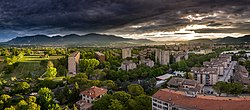Papigno
|
Terni Interamna Nahars |
|
|---|---|
| Comune | |
| Comune di Terni | |

Landscape of Terni
|
|
| Location of Terni in Italy | |
| Coordinates: 42°34′N 12°39′E / 42.567°N 12.650°ECoordinates: 42°34′N 12°39′E / 42.567°N 12.650°E | |
| Country | Italy |
| Region | Umbria |
| Province / Metropolitan city | Terni (TR) |
| Frazioni | Acquapalombo, Appecano, Battiferro, Cecalocco, Cesi, Collegiacone, Collescipoli, Collestatte, Giuncano Alto, Giuncano Scalo, Marmore, Miranda, Papigno, Piediluco, Poggio Lavarino, Polenaco, Porzano, Pracchia, Rocca San Zenone, San Carlo, San Liberatore, Titurano, Torreorsina |
| Government | |
| • Mayor | Leopoldo Di Girolamo (Democratic Party) |
| Area | |
| • Total | 211 km2 (81 sq mi) |
| Elevation | 130 m (430 ft) |
| Population (1 April 2015) | |
| • Total | 111,955 |
| • Density | 530/km2 (1,400/sq mi) |
| Demonym(s) | Ternani |
| Time zone | CET (UTC+1) |
| • Summer (DST) | CEST (UTC+2) |
| Postal code | 05100 |
| Dialing code | 0744 |
| Patron saint | Saint Valentine |
| Saint day | February 14 |
| Website | Official website |
Terni [ˈtɛrni] ![]() listen (Latin: Interamna Nahars) is a city in the southern portion of the Region of Umbria in central Italy. The city is the capital of the province of Terni, located in the plain of the Nera river. It is 104 kilometres (65 miles) northeast of Rome.
listen (Latin: Interamna Nahars) is a city in the southern portion of the Region of Umbria in central Italy. The city is the capital of the province of Terni, located in the plain of the Nera river. It is 104 kilometres (65 miles) northeast of Rome.
It was founded as an Ancient Roman town.
During the 19th century, steel mills were introduced and led the city to have a role in the second industrial revolution in Italy. Because of its industrial importance, the city was heavily bombed during World War II by the Allies. It still remains an industrial hub, and has been nicknamed "The Steel City" and the "Italian Manchester".
Terni also advertises itself as a "City of Lovers", as its patron saint, Saint Valentine, was born and became a bishop here and the remains are preserved in the basilica-sanctuary in his honor.
The city was founded around the 7th century BC by the Umbrians Naharti, in a territory inhabited (as testified by archaeological excavations of several necropolises) as early as the Bronze Age. In the 3rd century BC it was conquered by the Romans and soon became an important municipium lying on the Via Flaminia. The Roman name was Interamna, meaning "in between two rivers". During the Roman Empire the city was enriched with several buildings, including aqueducts, walls, an amphitheater, a theater, temples and bridges.
...
Wikipedia

